
Sustainable Furniture
User-Centered Design Project
518 Fall 2022
Project Details
Organization: University of Washington, HCDE Department
Project Type: User- Centered Design
Project
My Role: UX Researcher
Tools Used: Figma
Team: Pranali Raorane, Leo Dai, Theertha Shetty, and Vivian Xiao.
Project Timeline: October 2022- December 2022
10 Weeks
My Responsibilities: User Research, Usability Testing, Usability Analysis, and Design Interventions.
Project Context
For addressing the theme, “Designing for a Changing Environment” of the User- Centered Design class, my team and I proposed the sustainable furniture domain as a problem space to address. We leveraged the University of Washington's Surplus Store- which is a public store where the University sells surplus products to the UW community, to build our solutions on and make sustainable furniture accessible to UW students and the overall UW community.
Problem
Young people move around often due to school or work, and the moving process requires buying and selling furniture. During the process, they face several challenges such as transportation, carrying heavy objects, lack of time, the validity of the seller and the state of the furniture.
Design Question
“How can we improve the experience of buying and reselling furniture sustainably for young adults who are frequently moving to new places?”
Our Solution
Our Project Video
Process

Research
Secondary Research:
1. Literature Review
2. Competitive Analysis
Primary Research:
1.Surveys
2. Semi-structured Interviews
3. Contextual Inquiry
Why Use These Methods?
The Literature Review helped me understand why individuals implement sustainable practices, what encourages them to continue these practices, and what are factors that influence positive sustainable behavior change.
The Competitive Analysis aided the understanding of the current market in sustainable furniture. Comparing the existing outfits that purport sustainability like Facebook Marketplace and OfferUp shed some light on what they are doing well and where they are lacking.
The Surveys helped in understanding what most students and newly graduated individuals have issues with, what they want to be doing more efficiently and what their issues are in practicing sustainable furniture practices. The surveys showed that most first-year students have issues buying and furniture, and most newly-graduated students have problems selling furniture.
After the Surveys, given the time constraints and nature of our project, we decided to focus on University of Washington students to understand what their pain points were with respect to our topic.
Semi-structured Interviews were undertaken to delve deeper in the problem space and empathize with the students. It was also understood that current UW students were aware and utilized the UW Surplus Store, however, faced major transportation issues.

Check out the whole User Research Here!
Contextual Inquiry
We visited the UW Surplus warehouse and conducted stakeholder interviews with staff members to understand their operations and key challenges.
Images from the UW Surplus Store Site Visit

Target Audience
A. Primary users
1. College Students
2. Newly Graduated Students
B. Stakeholders
1. UW Surplus
2. Student Cooperative
Analysis
Problem Statement
Students need more efficient and feasible solutions to buy and sell furniture than currently present in the market. To encourage more students to participate in this sustainability venture, a coherent system is required.
Personas

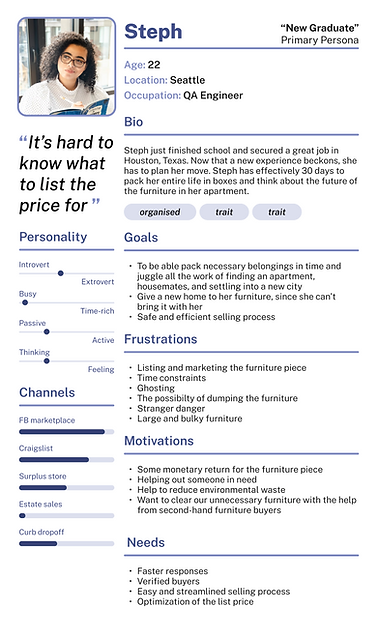
Design Requirements
-
Fast turnaround and communication
-
User profile verification
-
Education and events of sustainable furniture
Our research shed light on what our design requirements were
-
Provide affordable second hand furniture
-
Make it easy for students who don’t have a car
-
Consistent furniture listing information
Brainstorming
Ideation
During our brainstorm sessions, we sketched a wide range of ideas and then created an affinity diagram to examine each theme.
Our most promising ideas were: AI search tools to help buyers and sellers, collaborating with the UW Surplus store, and improving furniture quality through fix it workshops.
Brainstorming
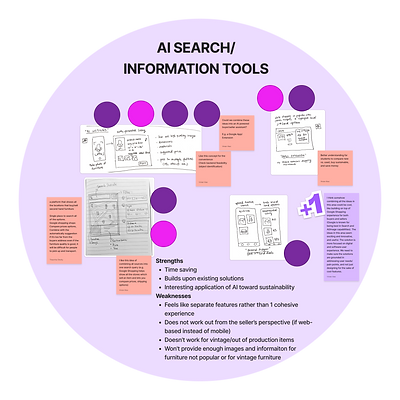
Service Diagram
In order to illustrate how our proposed service would work, we created a service diagram of the proposed collaboration with the UW Surplus Store, involving a student co-operation.
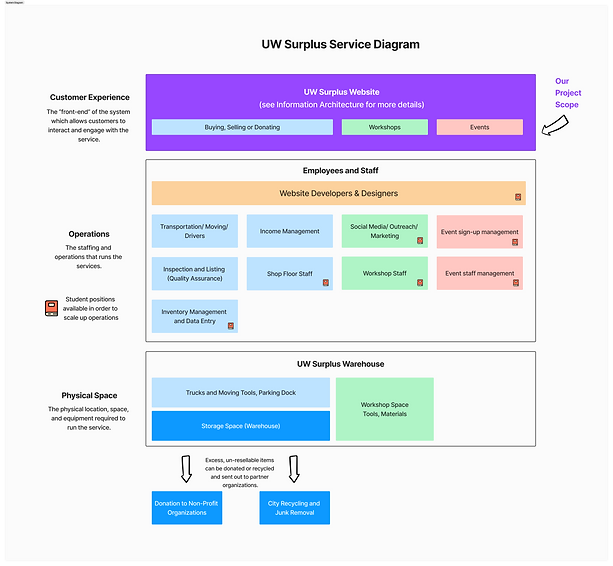
Service Diagram
Information Architecture

User/Task Flows
The following user flows show the end to end experiences for students who are buying, selling, or fixing furniture through the UW Surplus platform.
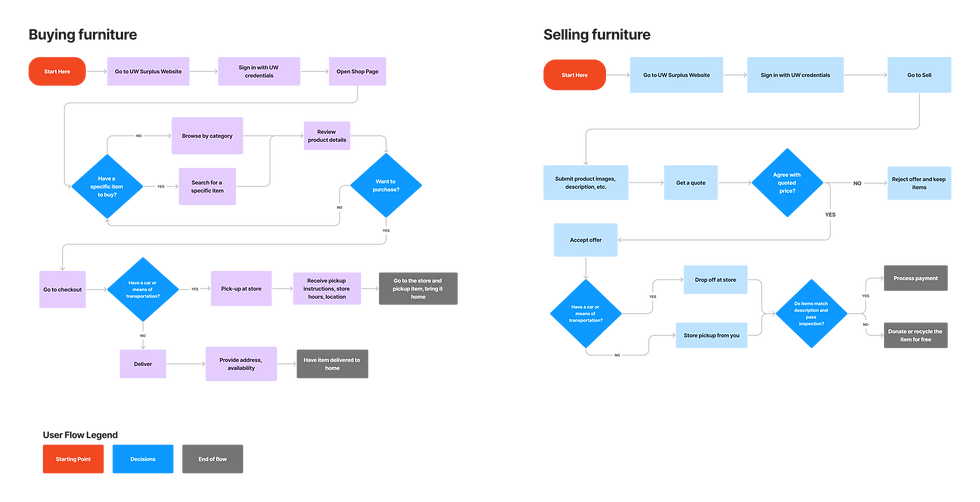
Mid-Fidelity Prototype
We created a medium fidelity prototype to show the core user flows for buying and selling furniture on the UW Surplus platform. The prototype is interactive so that we could run a usability test on the website. Try the prototype on Figma

Testing
Usability Testing
A total of 4 participants, who were all graduate students at the UW were recruited. The test was focused on shedding light on the understanding and discoverability of the website prototype. Whether they were able to understand the flow of the website, and if they faced any challenges or issues during the completion of any particular task was taken into consideration. You can find the full Usability Script, Analysis, and Report here!
Analysis and Findings
Data Analysis Grid for the Usability Tests
What Went Well
What Did Not Go So Well
Suggestions
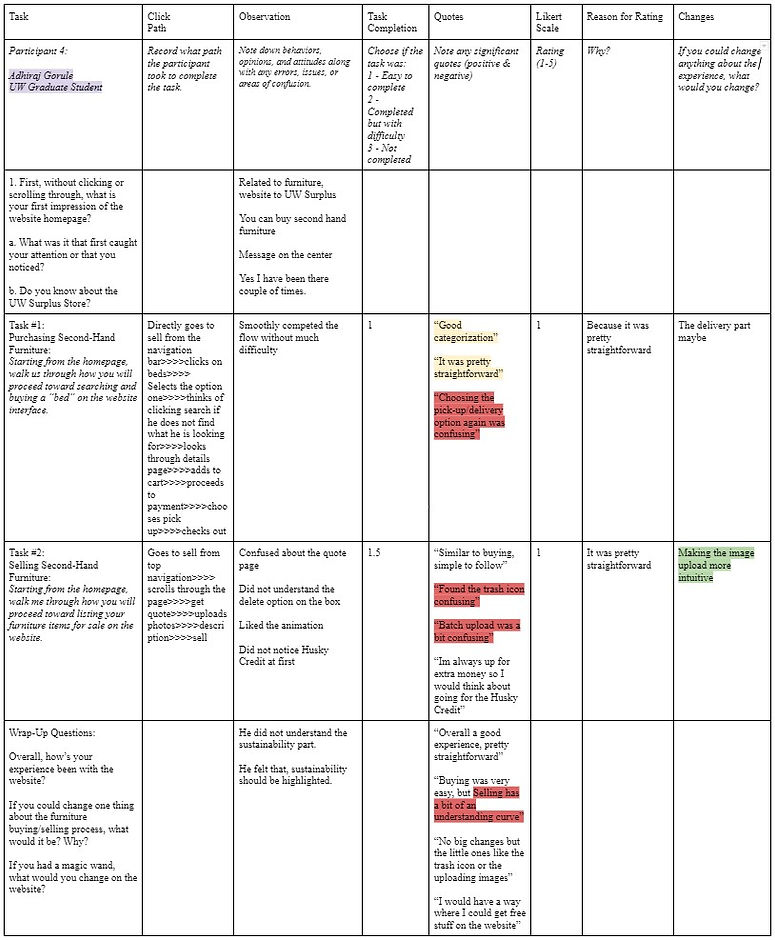
Usability Test Analysis
Iteration
Prioritization
After reviewing all the feedback, we prioritized them based on the following criteria:
Must fix: High severity usability issues and key to core functionality and user flows
Good to fix: Medium severity usability issues that can improve the experience
Nice to fix: Not urgent but could be considered in the future
Read the whole Evaluation Report Here!


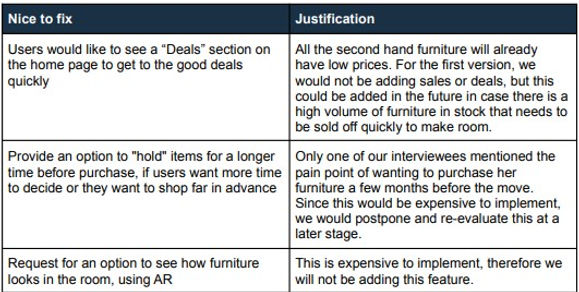
Incorporating Design Changes
1. Providing A Way To Filter by Price and Other Criteria

BEFORE
The Product list page didn’t account for a filter based search.
Users found it difficult to search for products in their price range.
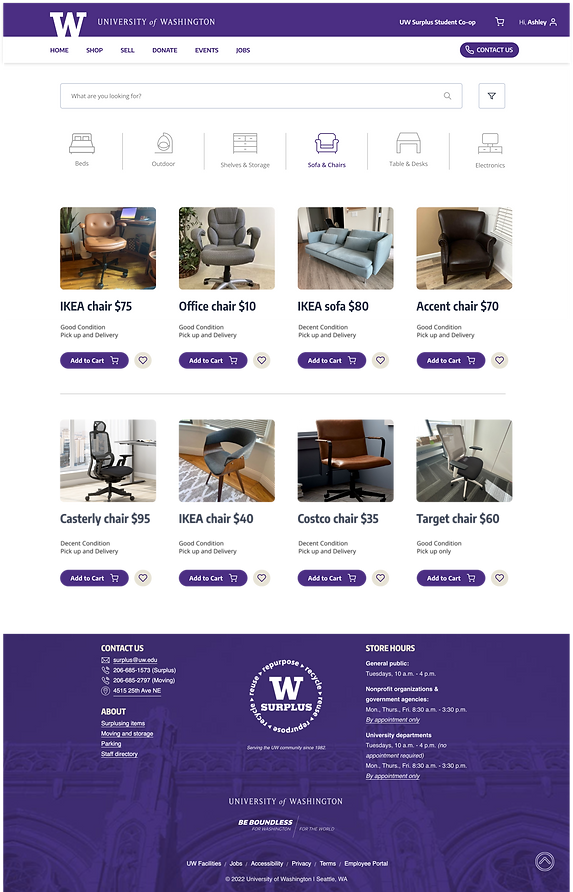
AFTER
A filter button next to the search bar was added to help users find their ideal piece of furniture.
2. Reduce Cognitive Overload in The Checkout Screen
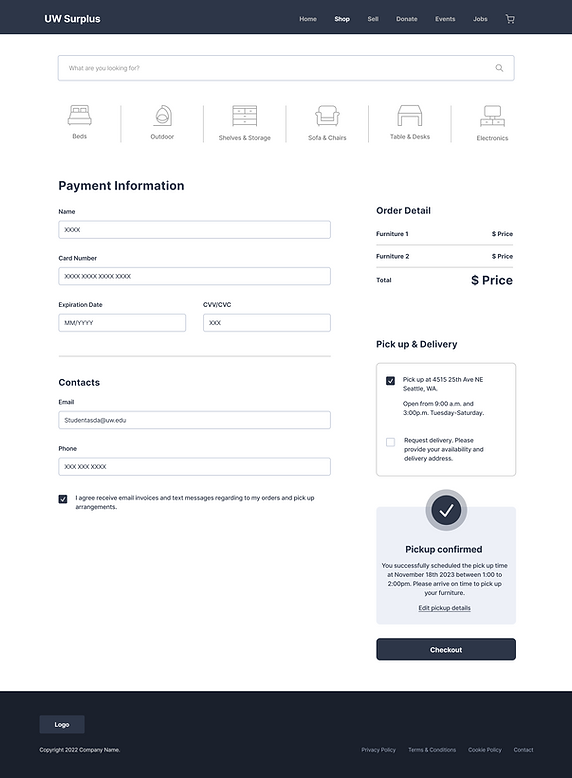
BEFORE
Too many elements and processes occurring simultaneously were bearing a cognitive overload on the user.
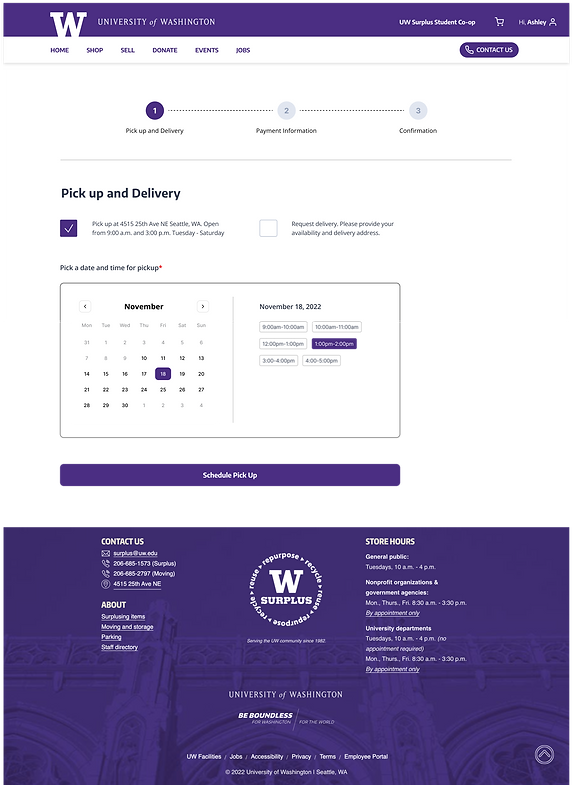
AFTER
Splitting the steps across different screens allowed the user to have a clear understanding of the context during focus oriented processes- payment.
3. Making The Batch Upload Feature Intuitive
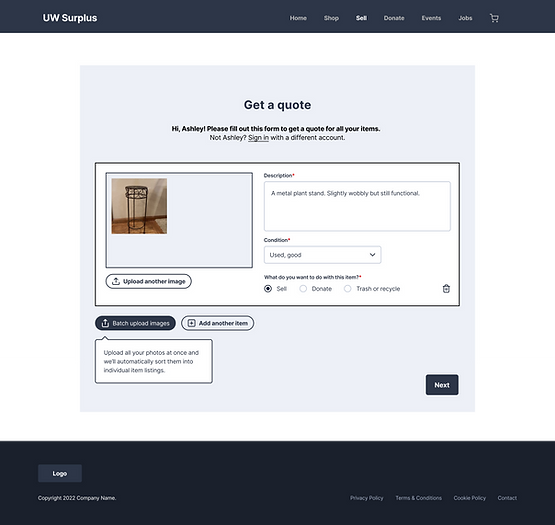
BEFORE
The text description wasn’t clear enough and user’s didn’t know what images to upload.
It was not clear how to change the image, delete it, or move it to a different listing.
AFTER
The addition of an introductory screen to the quote form for users to read about the “Quick Quote” option and understand how it works helped.
Uploaded images could be deleted or moved to a different section with the new changes.
High-Fidelity Prototype- Design Solution
The high fidelity prototype was presented after several rounds of iterations by including the UW branding elements, improvements on pickup and delivery and refinements on sellers listing experience. Try the prototype on Figma.
On our Solution:
"We wanted to instill in the UW community, feelings of an unwavering spirit of helpfulness, appreciation, trust, safety and sustainability."

High-Fidelity Screens
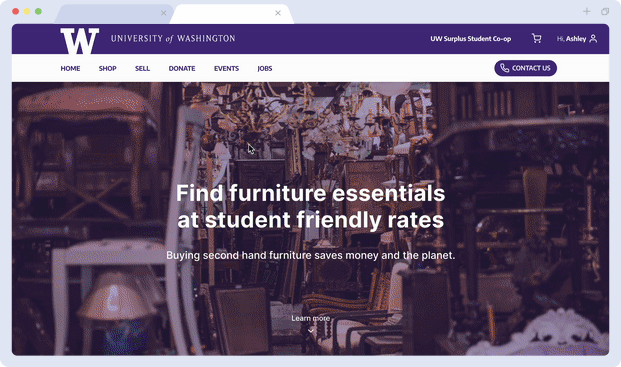
Buying Flow
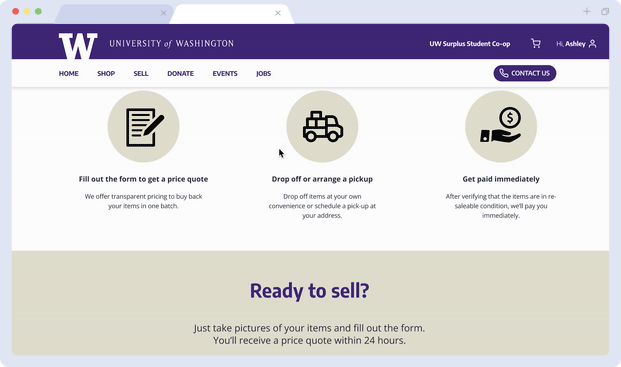
Selling Flow
If we had more time to work on the project, there are a few ideas which we could continue to explore to improve the platform:
-
Allowing shoppers to create a Wishlist and notify them when products become available
-
Showing Similar products on the product detail page
-
Ability to pay to place furniture on Hold for an extended time period to allow alignment with move-in timeframe
-
Adding a Deals Banner on the Home page
Future Explorations


